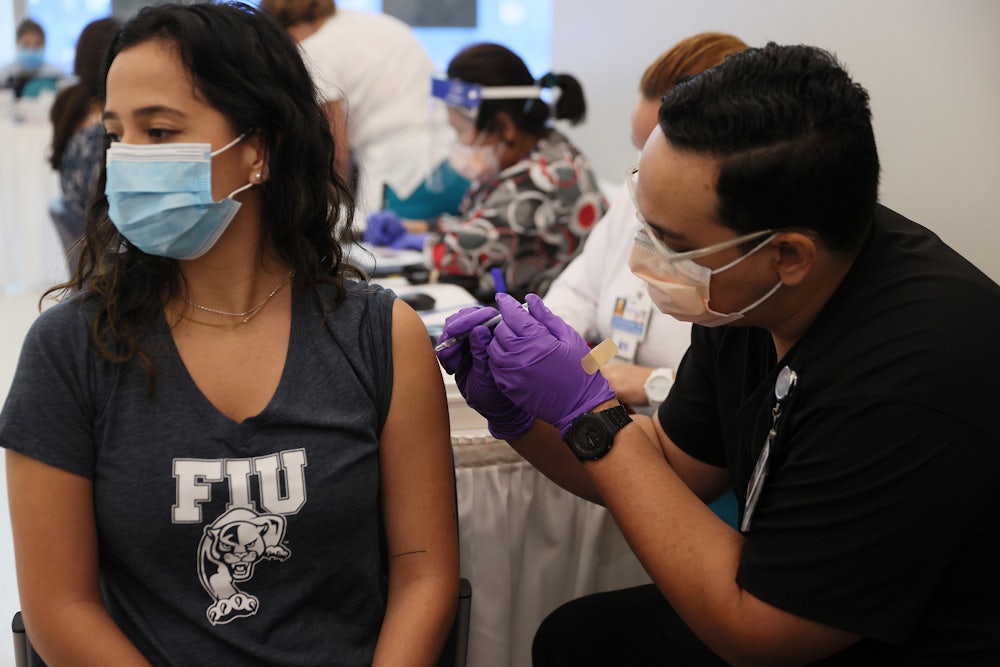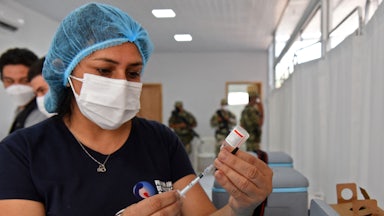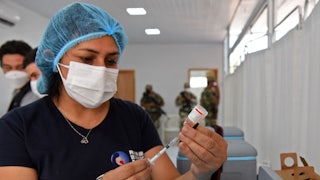When the Johnson & Johnson Covid-19 vaccine was temporarily paused after six people got blood clots postvaccination, one line of response was frustration that six out of around seven million people could prompt what seemed an extreme intervention. The Food and Drug Administration emphasized that the measure was taken in part because administering a typical treatment for blood clots had adverse effects with the six cases seen postvaccine—a type of clot called cerebral venous sinus thrombosis—and it wanted to make sure doctors everywhere could “plan for proper recognition and management due to the unique treatment required.”
The risk factor was inarguably low, which the Centers for Disease Control and Prevention and FDA also emphasized, especially compared with other risks the medical establishment tends to approve. One thread that emerged quickly in the public response was that we’ve long known that taking certain types of contraception—what’s called combined hormonal contraceptives, which contain estrogen and progestin—carries a risk of blood clots. According to the FDA, “If 10,000 women who are not pregnant and do not use birth control pills are followed for one year, between 1 and 5 of these women will develop a blood clot.” Those numbers increase to three and nine for people taking combined hormonal oral contraceptives; the risk increases even further for people who smoke or have a family history of blood clots, among other factors.
As experts have been quick to point out over the last couple of days, these are not meant to be one-to-one comparisons. The clots found in the six recipients of the Johnson & Johnson vaccine are much more rare, and more difficult to treat, than those caused by certain kinds of contraceptives. Risk also exists in a universe of other risks; one can’t assess the relative dangers of certain kinds of contraceptives without considering them alongside the risks of pregnancy and childbirth. Still, the response, muddled as it may have been in certain cases, points back to larger questions about risks shared unequally in a wildly unequal system. What’s considered acceptable—indignities and pain endured, lives cut short by preventable and treatable illness—is a map of who is valued and who isn’t. This is what the birth control statistics, tossed back and forth on social media this week and contextualized and recontextualized in countless explainers, were ultimately about.
Tolerance for medical risk is mediated by a variety of factors, all of which entwine with systemic erasures and biases: Women’s health concerns are dismissed more and studied less; Black women have an exponentially greater risk of dying in childbirth and of having their self-reported health concerns ignored (even if they’re as powerful as, say, Serena Williams); implicit bias has been shown in studies to result in objectively worse care, with doctors spending less time with Black patients. Trans and gender-nonconforming patients face pervasive discrimination while seeking health care and are routinely denied needed services. Tech has been no help: The health care system’s turn to algorithms to determine allocation of care was assumed to be a neutral effort, but a 2019 study found that a widely used algorithm’s racial bias was so severe, correcting it would increase the proportion of Black patients prioritized for care from 17 percent to 46 percent. Algorithms that determine allocation of health services used patients’ history of health care costs. Unsurprisingly, a profit-focused health care system that sees patients as wallets rather than people misses quite a bit.
Risks are tolerated in other ways: Poverty increases risk of mental illness, chronic disease, and death and is correlated to lower life expectancy. “Cyclically, poverty leads to poor health and poor health leads to poverty,” Kirsten Bibbins-Domingo, director of the University of California, San Francisco’s Center for Vulnerable Populations, observed in 2016. “If that cycle happens across generations, then you are talking about major, seemingly intractable effects on communities living in poverty.” Yet we don’t treat poverty as a public health crisis. Instead, the wealthy biohacker boys of Silicon Valley play with “young blood” to see if they can attain immortality.
Research and diagnosis methods tend to favor cis men. More women die of heart attacks than men; women’s heart attacks are also often misdiagnosed when they exhibit different symptoms than men and tend to have worse outcomes when treated by male physicians, yet cardiac research still heavily centers men, and the odds of gaining a full professorship in cardiology are 37 percent lower for women than for men. Attention-deficit/hyperactivity disorder often presents differently in women and men, or girls and boys, and thus for at least two decades, girls were chronically underdiagnosed, leaving many unable to develop skills to cope with a neurological condition that would continue to trouble them as adults, and resulting in higher rates of anxiety and depression.
Research involving trans people is often narrowly tailored to certain kinds of health interventions; testing populations are still broken down largely along an inadequate male-female binary. As the BBC reported last year, “Rather than devising new ways to cope with changing social norms, transgender people are often shoehorned into inappropriate boxes instead.” Discrimination and lack of access to knowledgeable providers create tremendous barriers to health care for trans patients of all ages, who frequently experience all of the same negative outcomes as other marginalized groups, only “significantly magnified,” according to a 2016 study.
These biases are relentlessly correlated with negative outcomes. Patients are talked down to, and their lived experience devalued, particularly in the fields of chronic illness and mental or reproductive health, where patients often become autodidacts as a result of being dismissed and mistreated. A 2012 meta-analysis of 20 years of studies found that Black patients were 22 percent less likely than white patients to receive any pain medication when accessing care. A quick scan of the news reveals countless stories of Black women being ignored, with catastrophic consequences, by their doctors. “Wellness,” now about as powerful, and often dubious, a cottage industry as we’ve ever seen, grew out of the near-categorical dismissal of women’s health issues.
There’s a bias, too, against those who are chronically ill, the very people who need the health care system most. Insulin prices in the U.S. are eight times higher than in equivalent nations. Going without insulin, for those who need it, can be fatal. Somehow, that’s a risk the U.S. health care system and corresponding government entities are OK with. And while the U.S. won’t legislate to provide care—including vital medications—to those who need them, it will eagerly legislate to deny care. More than 45,000 transgender children in 21 states are currently losing or at risk of losing access to health care due to legislation that won’t accept the supposed risk of allowing parents and doctors to determine the health needs of children in their care. In every single state passing such legislation, corporal punishment is legal in schools, allowing teachers and administrators to discipline children in a fundamentally sexual way, despite clear evidence that such punishments overwhelmingly affect Black students and also result in the same adverse neurological effects as more severe, definitively illegal violent and sexual abuse.
The greatest risk inequitably enforced in this country is the most essential: general well-being. It is allowable, under our present systems, for trans people, for women, for Black women in particular, for poor people, for fat people, for the mentally ill, for the chronically ill and disabled, all to have worse health outcomes—these things are accepted and narrated to us by powerful institutions as an unfortunate but inescapable fact of medicine. And in doing so, they reiterate that these people are of lesser value, and are in fact inconvenient. These people are a burden, and so they should be grateful for what they get.
There was a hope among some at the very early start of the pandemic that, as horrific as it was going to be, it might force people with privilege to see how inextricably all of our lives are intertwined, how the health of one person isn’t just their health but yours, too. We had to learn to wear masks not to protect ourselves but to protect others. Those with money suffered inconvenience at the very least from the fact that the people who serve and enable their lifestyles had no access to health care, to childcare, to workplace protections, to a real, functioning social safety net—to any of the things that would allow them to stay home when sick, instead of risking a widespread infection to pack boxes for Amazon.
It would be impossible, as well as wholly undesirable, to avoid risk entirely in medical enterprise. Medicine is science, and science is experimentation, and experimentation can only happen if we take risks. And there’s just no such thing as a risk-free existence. Aversion to risk in some contexts contributed to the inequities we’re dealing with today: In the 1970s, the FDA decided women “of childbearing age” shouldn’t participate in clinical trials, out of concern not for the participants themselves but for possible future fetuses. As a result, it became the norm for new medicine to be developed exclusively on men; eight of the 10 prescription drugs withdrawn from the market between 1997 and 2000 “posed greater health risks for women than for men.”
The problem arises when a constitutionally unequal system assumes that the calculus by which we accept risk is neutral, rather than critically analyzing not just how research and regulatory decisions are made but how services are both distributed and received. A medical establishment predicated on the acceptance of profit-driven health care will inevitably favor the wealthy and the powerful, at the expense of everyone else.
Because wealthy and powerful people don’t want to risk a system that isn’t subject to their whims, we accept as inevitable a system that is abjectly unequal. The nonrisks or edge-case inconveniences of change—What if I don’t like the doctors I have access to in a public health system? What if the contours of something meant for everyone, equally, are inconvenient to me?—consume the whole of the conversation, even as the real risk for millions of people is leaving the current system in place.








